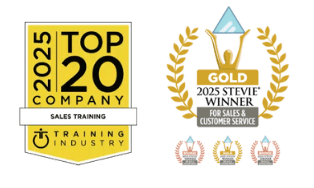Many people believe the ultimate goal in working with our clients is to become their “partner,” and not just another vendor. Yet, in a traditional selling process, most salespeople have several conversations with the client about their offerings and needs, until we hopefully find a match. Or, in a typical procurement process, the client will tell us what they want and exactly how they want it.
In either case, we gather our experts, sharpen our pencils, and create our best proposal (that the actual decision-makers rarely read). We hope the client makes the right decision and selects us. Except that’s not selling. That’s what we call “hoping to win” – and we all know hope is not a strategy!
If this is how you’re selling today, I encourage you to examine your win rates. I’m betting they’re 30% or less, which means you’re LOSING more than 70% of your deals.
McKinsey Research predicts within the next 2-4 years, 50% of today’s sellers will be replaced by technology, which means salespeople who employ this transactional approach to selling will be replaced by smart chat bots or inside salespeople.
Here are four things you can do to truly elevate your status to partner. At Revenue Storm, we call it becoming a “Political Insider.” Protect yourself from commoditization and increase your win rates.
- Start with a vision.
Rather than go into a client relationship searching for a need or with a specific product or service in mind you hope to sell, create a vision for the business value you can help deliver. Use the TIPSTM Framework and the Value VisionTM Template to create thought leadership so you can lead with a point of view instead.
- Collaborate to create a bundled solution.
Leverage the 7-SlideTM Deck as your passport to have a series of collaborative discussions with multiple doors in your client. Use these discussions to validate and strengthen your vision to create a customized solution that might include 1) multiple products and services, and 2) initiatives and actions the client will take to achieve the desired business results. Remember, you don’t have to provide the entire solution, you just have to help enable it to support the outcomes.
I once coached a deal where the salesperson collaborated with numerous client doors in 55 separate meetings or phone calls. He started the opportunity thinking it was worth €3 million. By the time he closed it after six months of collaboration, he had built a bundled solution tied to specific business outcomes worth €18 million. I call that “emptying the shelves.” It demonstrates the importance of leading with a Value Vision where any and all products and services that can contribute to the ultimate business outcomes can be added to the solution bundle.
- Build business cases, not proposals.
Whether you realize it or not, every buying decision a client makes ultimately requires an internal business case, even if it’s done informally. That business case typically details the internal and external costs a client will have to incur to implement your solution, beyond the actual cost of your offering, as well as the anticipated business results and the return on investment.
Oftentimes, a client isn’t completely certain what those costs, results, and return will be, so they rely on your price as the key decision criteria. Giving them a proposal with just the costs of your offering, along with non-quantifiable statements regarding the value of what you are selling, forces you into a commoditized price trap.
Instead, use the collaborative discussions in #2 to identify, quantify, and gain agreement on all the elements required in the business case – especially the anticipated business results and the value they can expect to achieve. Use the Value ContributionTM Template as the format for your business case, either in written or presentation form.
- Create internal partners to help you sell.
Finally, collaboration requires you to proactively create Partner Allies to help sell your business case. Identify people who believe they have something personal to gain by implementing your solution over that of a competitor. People who will help coach you, sell for you internally, and take political risk on your behalf. This is critical to this selling approach.
One final word on collaboration. Watch for a client relationship that is not collaborative – one that is not willing to meet with you to discuss and provide input on your Value Vision, to provide confidential information to help you strengthen and quantify your solution, or to help sell the business case internally. It is probably not worth it to invest your time with them. Qualify them out!
Personal Challenge:
In a key pursuit, where you are early enough in the sales cycle, change your sales objective. Move from selling a particular product or service to selling the creation of a business case through a collaborative shaping process of the client relationship.




